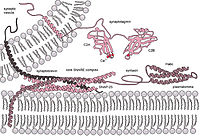
Electrophysiology on Channel-Forming Proteins in Artificial Lipid Bilayers: Next-Generation Instrumentation for Multiple Recordings in Parallel.
Sign Up to like & getrecommendations! Published in 2021 at "Methods in molecular biology"
DOI: 10.1007/978-1-0716-0818-0_4
Abstract: Artificial lipid bilayers have been used for several decades to study channel-forming pores and ion channels in membranes. Until recently, the classical two-chamber setups have been primarily used for studying the biophysical properties of pore… read more here.
Keywords: electrophysiology channel; lipid bilayers; proteins artificial; channel forming ... See more keywords

Topological features of the intermolecular contacts in gluten-forming proteins: Exploring a novel methodological approach based on gold nanoparticles.
Sign Up to like & getrecommendations! Published in 2019 at "Food research international"
DOI: 10.1016/j.foodres.2019.01.013
Abstract: This work introduces a novel methodological approach to study both the geometry of complex protein networks and the nature of the interacting proteins. This approach is based on the high reactivity of Au+ ions on… read more here.
Keywords: protein; methodological approach; gluten forming; novel methodological ... See more keywords

Gasdermin and gasdermin-like pore-forming proteins in invertebrates, fungi and bacteria.
Sign Up to like & getrecommendations! Published in 2021 at "Journal of molecular biology"
DOI: 10.1016/j.jmb.2021.167273
Abstract: The gasdermin family of pore-forming proteins (PFPs) has recently emerged as key molecular players controlling immune-related cell death in mammals. Characterized mammalian gasdermins are activated through proteolytic cleavage by caspases or serine proteases, which remove… read more here.
Keywords: death; fungi bacteria; pore forming; cell death ... See more keywords

Sticholysins, pore-forming proteins from a marine anemone can induce maturation of dendritic cells through a TLR4 dependent-pathway.
Sign Up to like & getrecommendations! Published in 2021 at "Molecular immunology"
DOI: 10.1016/j.molimm.2020.12.032
Abstract: Sticholysins (Sts) I and II (StI and StII) are pore-forming proteins (PFPs), purified from the Caribbean Sea anemone Stichodactyla helianthus. StII encapsulated into liposomes induces a robust antigen-specific cytotoxic CD8+ T lymphocytes (CTL) response and… read more here.
Keywords: response; ctl response; dendritic cells; pore forming ... See more keywords

Knocking 'em Dead: Pore-Forming Proteins in Immune Defense.
Sign Up to like & getrecommendations! Published in 2020 at "Annual review of immunology"
DOI: 10.1146/annurev-immunol-111319-023800
Abstract: Immune cells use a variety of membrane-disrupting proteins [complement, perforin, perforin-2, granulysin, gasdermins, mixed lineage kinase domain-like pseudokinase (MLKL)] to induce different kinds of death of microbes and host cells, some of which cause inflammation.… read more here.
Keywords: dead pore; knocking dead; pore forming; forming proteins ... See more keywords

Functional and Structural Variation among Sticholysins, Pore-Forming Proteins from the Sea Anemone Stichodactyla helianthus
Sign Up to like & getrecommendations! Published in 2020 at "International Journal of Molecular Sciences"
DOI: 10.3390/ijms21238915
Abstract: Venoms constitute complex mixtures of many different molecules arising from evolution in processes driven by continuous prey–predator interactions. One of the most common compounds in these venomous cocktails are pore-forming proteins, a family of toxins… read more here.
Keywords: functional structural; variation among; stichodactyla helianthus; pore forming ... See more keywords

Rotational Dynamics of The Transmembrane Domains Play an Important Role in Peptide Dynamics of Viral Fusion and Ion Channel Forming Proteins—A Molecular Dynamics Simulation Study
Sign Up to like & getrecommendations! Published in 2022 at "Viruses"
DOI: 10.3390/v14040699
Abstract: Focusing on the transmembrane domains (TMDs) of viral fusion and channel-forming proteins (VCPs), experimentally available and newly generated peptides in an ideal conformation of the S and E proteins of severe acute respiratory syndrome coronavirus… read more here.
Keywords: channel; fusion; forming proteins; viral fusion ... See more keywords